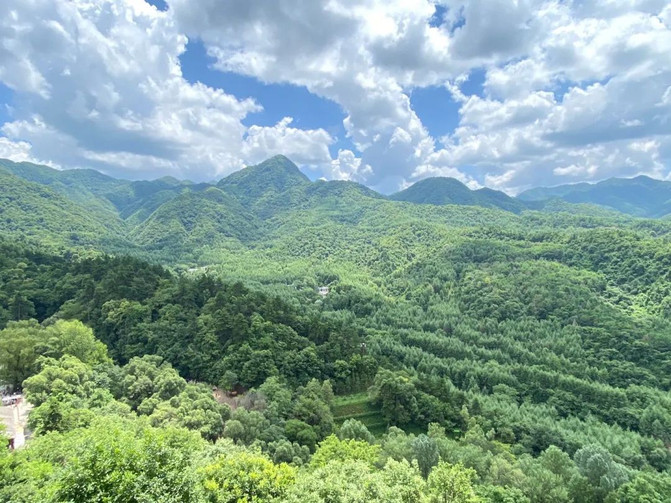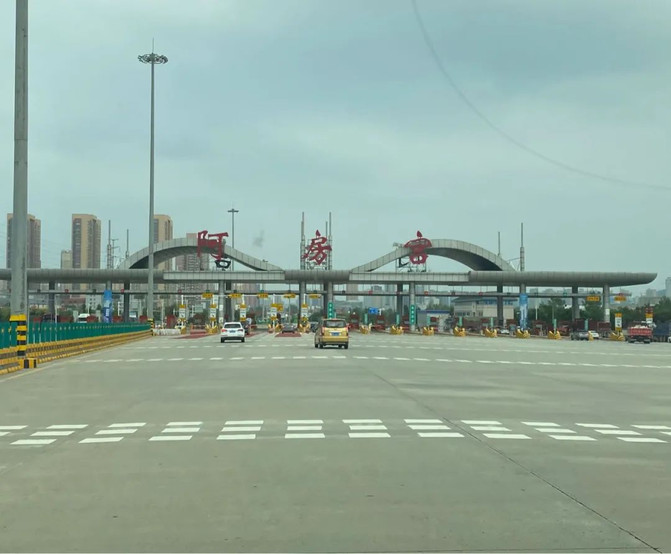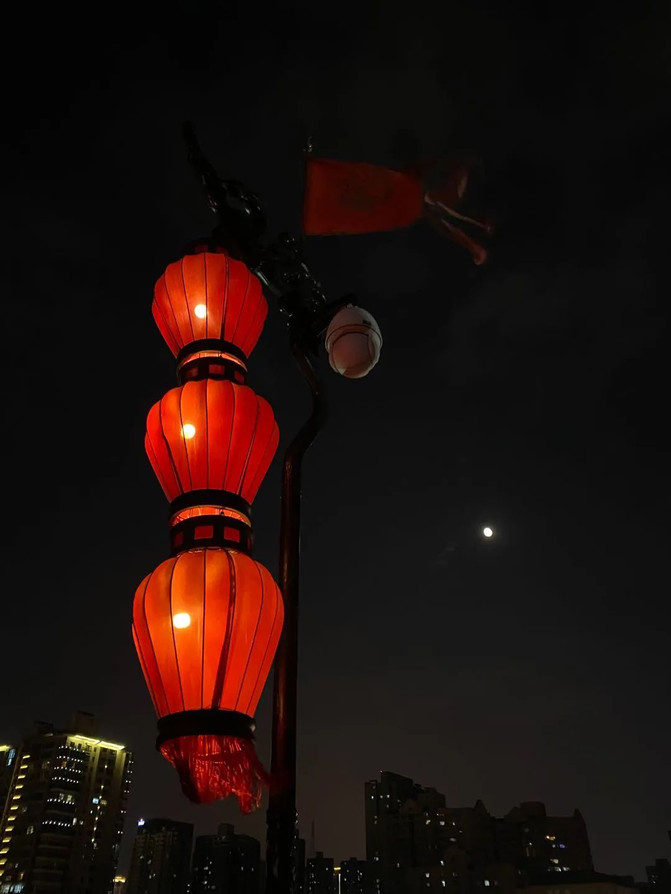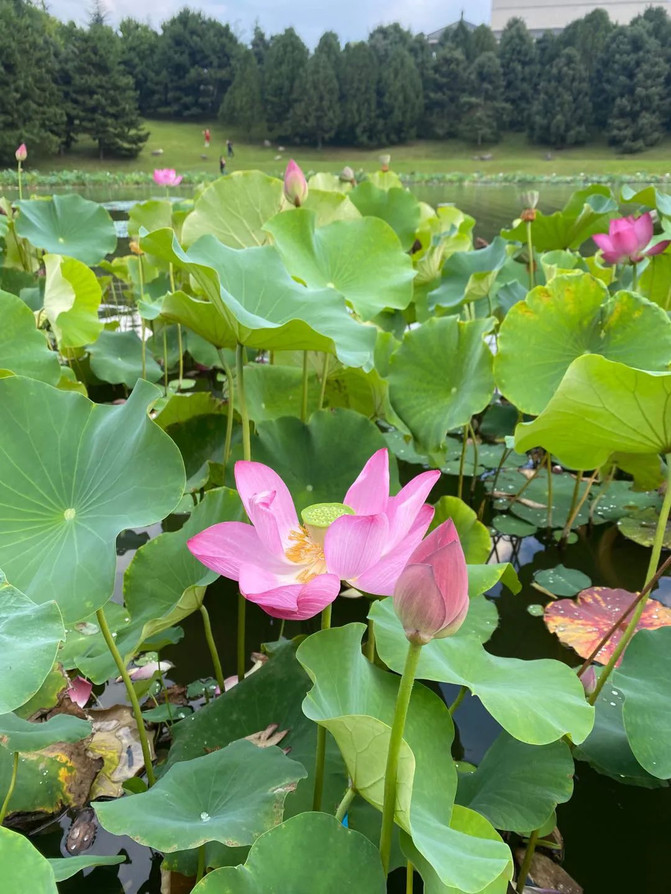The starting point is the end, returning to the world. The return journey westward of the Northwest Grand Ring Road is slowly concluded
Taking the G6 Beijing-Tibet Expressway from Xining east to Beijing was undoubtedly the best choice, but we didn't plan to take the old road back, so we took a different path and passed through Tianshui, Xi'an, Taiyuan, Gansu, and finally returned to Beijing.
First stop, Tianshui
Tianshui is the first check-in place on the return journey. From Xining to the east into Gansu, the landform changes are obvious. This place is like cutting a knife and an axe, rough and majestic. I traveled through mountains and tunnels all the way. This road included almost all the tunnels in Gansu Province. The tunnel group was one after another, feeling like endless black holes and flashing light until the end of time. The Yellow River twists and turns among the mountains and valleys here. When you often pass through the tunnel, you will see the Yellow River under the bridge. It is so much that you even have the illusion that you are spinning in place and never moving forward. Such road conditions reach the Xigu section of Lanzhou. The entire Urban area of Xigu is scattered on the Loess Plateau. From a distance, it stands between the plateau ravines. The high and low buildings look like a city in the sky. The landform of the Loess Plateau is very similar to Yadan. Except for the greening in the city, there is almost no grass growing in the valley. Just passing by here has given people endless loneliness. Qi Dad especially admires the residents here. We just miss each other. It's so difficult for them to live here every day!
Satellite cloud images show that there is no flat land on this road, but endless plateaus and mountains.
…

I thought Tianshui might also be a continuation of this desolate journey, but I didn't expect that the scenery would change as soon as I entered Tianshui. Here, the mountains are lined with green mountains and verdant everywhere. The city is built along the river. The water and sky are in the same color, just like Jiangnan!
A few days ago, we have traveled to the desolation of the Northwest, and the vitality here is a bit unexpected! Qi Dad even had the illusion of walking in his hometown in the south. No wonder it was named Tianshui. Suddenly, a divine song said,"Take a cup of water from the sky and shine it on the bright moon and sway the world. Love and hate are just a moment, swaying in the mortal world." Ordinary people like us yearn for heaven, but we cannot leave the world. Ideal and reality are intertwined.

Tianshui was called Qinzhou in ancient times and is located in the southeast of Gansu, the western section of the Qinling Mountains, and the middle reaches of the Weishui River. Tianshui has a long history and culture. It is an important birthplace of the Chinese nation and Chinese civilization, the birthplace of Fuxi, the "first of the three emperors", and is known as the "Hometown of Emperor Xi". The "five major cultures" represented by Fuxi culture, Dadiwan culture, early Qin culture, Maijishan grotto culture and the ancient battlefield culture of the Three Kingdoms constitute Tianshui's rich historical and cultural resources.
To Tianshui, I only came for the Maijishan Grottoes. The next day and only trip was naturally the Maijishan Grottoes.
Tianshui maijishan grottoes
Maijishan Grottoes, one of the four major grottoes in China, are a dazzling artistic pearl on the ancient Silk Road. Maiji Mountain is located in Maiji District, Tianshui City, Gansu Province. It is a lonely peak in Xiaolong Mountain. It is 142 meters high and is named for its shape resembling a wheat stack. Maijishan Grottoes were built from 384 to 417. There are a large number of grottoes and clay sculptures. They are known as the Oriental Sculpture Art Exhibition Hall.
A rising lonely peak in front of you is Maiji Mountain. The grottoes are built in the cliffs from the bottom up. The peaks are towering and the Buddha statues stand on the cliffs, making you have to look up at the majesty of this Buddhist country.

This mountain is like a huge earth wall, almost straight up and down. I really admire the imagination and perseverance of the ancients. The grottoes came from Maiji Mountain, and Maiji Mountain also became famous because of the grottoes.

To visit the grottoes, you must go from the plank road. This plank road is now a reinforced concrete structure. In ancient times, it was a wooden plank road. It was later destroyed in troubled times. It is said that because the plank road was burned, the Buddha statues on the cliff were preserved during the war.

Qi Ma was afraid of heights. She climbed the plank road with surprise and shock, one foot deep and one foot shallow, but she could not forget Zhang Meizhao. Although she was close to the cliff, she still had her style. She could panic, but she could not lose her aura! If it is for beauty, everything can be thrown away.

Qi Xiaobao acted like an ignorant and fearless newborn calf. His emotions were high and he jumped up and down along the way! Qi's father has been worried. He wants to encourage Qi's mother who is afraid of heights on one side, and he wants to hold Qi Xiaobao who doesn't know how high and low he is. He obviously has no way to separate himself.

The Buddha statue is on this cliff, looking into the distance.

With such a close distance to the World Heritage Site, we Buddha are merciful. No matter from any angle, you will feel that the Buddha is watching you. Even on this cliff, you will not need the attention of the Buddha's eyes. The sculptures here have reasonable proportions, unique shapes and exquisite details. The carving art is still among the best among the four major grottoes.

With my Buddha's care, Qi Ma became much bolder. She seemed to have adapted to the feeling of being extremely cold at this high place, and took Qi Xiaobao and walked forward.

This king is worthy of being a king, this figure! This muscle! Even now, he is also an absolute fitness master! It can be seen that people's understanding of power in ancient and modern times is still highly consistent.

The Tianwang of Tannu outside Cave 005 was a work completed during the Sui Dynasty and the early Tang Dynasty. The appearance of the Tianwang of that era still had a very obvious image of the Hu people.

The two women have reached an agreement and started working on the same channel. Qi Dad has also merged into one from his schizophrenia all the way to perfection. Come on, you can take a serious picture this time! Hehe!

The plasticised statue of a strong man below Cave 191 has the shape of a human head and a bird's body. It is powerful and strong enough to be a little cute. This statue is from the Western Wei Dynasty, and it still has the obvious appearance of a Hu.

The Buddha statues in many caves here still retain some of their true colors under the mottled appearance. You can imagine how brilliant they were at that time.

Due to the need for cultural relics protection, many caves are sealed with dense barbed wire, and the outer layer is reinforced with iron fences. It is difficult to see clearly from the outside, let alone take photos! Personally, I think that since we want to open the tour, we should keep up with the times. Even if you build a glass cover, it will be better than this rusty barbed wire fence! At least it can be seen that the protection of cultural heritage should include innovation in the visiting experience. After all, you charge a lot of tickets! These dilapidated "windows" on Maijishan should be changed. They really spoil the scenery.

The plank road is a one-way route, with one entrance and the other exit. We reached the "corridor" at the highest point and descended the mountain from the exit at the other end.

Looking at the mountain from the foot of the mountain, it stands high into the clouds. The cliff where the Maijishan Grottoes are located is straight up and down like this.

Qi Xiaobao was full of pride in his bravery and competed with Qi Ma in front of the observation deck at the foot of the mountain! The trip to Maijishan Grottoes also came to a successful conclusion under the green trees of Maijishan.

These Buddha statues stared ahead silently, lifting their heads and rolling clouds, and lowering their heads, people coming and going. The Buddha statues looked for thousands of years, and everything in the world seemed to have changed unchanged. We are just floating in this sea of people, coming with the crowd and leaving with the crowd. Qi's father thought that in this life, all the encounters that people encounter are fate. Whether this mountain, this Buddha, and this person are accidental or inevitable, everything is beautiful!
Fate has a beginning and an end, things have a cause and an effect, everything is in awe, the heaven of heaven is a good reincarnation, and the right path is vicissitudes.

Although the trip to the Maijishan Grottoes was extremely cold high, it also made us feel refreshed because of the cliffs and dense vegetation! Walking all the way feels like the most relaxing and enjoyable day in the past few days. I returned to the hotel and had a pickled cabbage fish pot, which comforted my appetite for mutton that had been tired of eating for more than ten days. I went down the plateau, starting from Tianshui, from the body feeling to the taste buds, and I felt like I had finally returned to the long-lost world.
The road from Tianshui to Xi'an runs through greenery in canyons. The fog is clear all the way, as if you have entered a tropical rainforest. According to the region, this area should be the junction with the Qinling Mountains. The Qinling Mountains have a good ecology. It is indeed worthy of its reputation. The climate here is warm and the water vapor is abundant, and there is no sense of dryness and rough like the Northwest.
Xi'an, the ancient spiritual capital of Chinese people
Xi'an's toll station has a shining name-Afang Palace. I admire the courage of Xi'an's managers. With these three words, the glorious history of a city has been revealed without doubt.

Xi'an is the ancient capital of the 13th Dynasties. It is the city with the earliest and longest capital (more than 1200 years) in China, and the most dynasties in China. Condenses the essence of Chinese history: from the Western Zhou Dynasty of slavery, to the first unified Qin Empire, the Western Han Dynasty, the first prosperous dynasty, to the Tang Dynasty, the peak of feudal society, Xi'an wrote the most colorful chapter in Chinese history. It is currently recognized by the official and historical circles that 13 dynasties established their capitals here. It is the proper king of China's imperial capital and can also be said to be the spiritual ancient capital of the Chinese people.
ancient city wall of Xi'an
After dinner, at Qi Xiaobao's insistence, Qi's parents finally cheered up and decided to visit the ancient city wall. The streets on both sides of Yongning Gate are brightly lit, and the ancient capital of the thirteen dynasties is still full of vitality.

The bright moon hangs high, the lanterns are on, and people come and go on the ancient city wall. The once-tense ancient city building has become a leisure place for residents and tourists. The ancient city wall in the moonlight and the bustling markets inside and outside the city wall are unknowingly filled with those famous ancient poems: "During the Qin Dynasty, the bright moon was passed during the Han Dynasty, but the people of the Long March had not returned";"Chang 'an looked back at the embroidery piles, and thousands of doors on the top of the mountain opened one after another";"Wherever you travel, smiling into the Hu Ji wine shop." Although Chu Sha did not write about Chang 'an, it indirectly reflected the loneliness of Chang' an during the war. Du Mu's Guo Huaqing Palace described the extravagance of the ancient Chang 'an emperor's home, and Li Bai's youthful journey described the prosperity of Chang' an. Three Tang poems, three Chang 'an. A place with rich history and culture, stroll through it and step on classics with every step.

Qi Xiaobao's small figure was walking on the wide city wall. This height difference was just blocked by the battlements. In the eyes of Qi Xiaobao, Qi Xiaobao's prosperity was surrounded by walls on all sides.

The boring Qi Xiaobao needs the comfort of food, the juice from the cultural and creative shop on the city wall, which is a reward for the child's hard work.

This city wall warrior is cuter than Qi Xiaobao! In comics creation, if you want A cartoon feel, enlarging your head is an effective way, such as Doraemon. "Big head, big head, don't worry about the rain. People have umbrellas, but I have big head." Qi Dad's brain circuit has always been so clear!

Xi'an is very good at using the past for the present, and walking in it does not feel awkward.

The lanterns and the bright moon shine in the distance

Ancient and modern complement each other

There is always the illusion of Beijing in Xi'an. Perhaps it is all due to the ancient capital. China's imperial culture is inherited. For example, Chang' an Street in Beijing is called Chang 'an Street.

the Terracotta Warriors and horses
The Terracotta Warriors Museum, which is a must-check in to Xi'an, saw the station name as soon as you got off the highway. It seems that Xi'an is very direct in naming high-speed toll stations.

In Hall 3, the largest, Qin Shihuang's army is ready to go. They are waiting for the First Emperor's order to set out. This has been waiting for more than 2,000 years.

Qi Xiaobao had never seen such a scene before and was full of curiosity about the terracotta warriors, especially the headless terracotta warriors! Children's thinking mode is always simple and direct!

They stood upright, with solemn expressions and strict discipline. This was once the most powerful army in this land. It was they who broke through mountains and rivers for the Qin Dynasty and unified China. From then on, the planet had the concept of China.

Under the blue sky, the statue of Qin Shihuang looks down on this land. This was the place where he and the Great Qin Dynasty set out, and it also became their destination.

datang sleepless city
I heard that in addition to seeing the terracotta warriors and horses in Xi'an, the Tang Dynasty Sleepless City is also a must-see place. After dinner, he took Qi Xiaobao to walk out of the Tang Dynasty Sleepless City.

The Tang Dynasty Sleepless City is a large-scale pedestrian street built by Xi'an at a high cost. It is located at the foot of the Big Wild Goose Pagoda in Yanta District, Xi'an City, Shaanxi Province. It starts from the South Square of the Big Wild Goose Pagoda in the north, reaches the ruins of the Tang City Wall in the south, starts from Cien East Road in the east, and ends at Cien West Road in the west. It is a place to display and experience Tang culture with the Tang Dynasty culture as the background and Tang style elements as the main line.
Looking at the sea of people, I felt a little difficult to move forward. I didn't like the too lively family, so I had to leave in a hurry. On this day, it is like Meng Jiao's poem,"The spring breeze is full of galloping horses, and I see all Chang 'an flowers in one day." It's just that we weren't complacent, but we also saw all the Chang 'an flowers in one day. Chang' an was too big, and after a short stay, we could only take a quick look at the flowers.

The aftertaste of the Tang Dynasty can be seen everywhere in these streets and alleys

The next day, there was no itinerary scheduled during the day. The family slept well and went back to sleep. They took the time before the hotel breakfast ended to eat, and then went back to the room to catch up on sleep. During this day's sleep, the fatigue from travel was significantly reduced, which was for tomorrow's return journey to accumulate energy.
Tang Dynasty Chases Dreams
The highlight of the evening is also the last trip of this Northwest Ring Road, the large-scale scene performance of "Tang Dynasty Dream Chasing" at the Tang Dynasty Furong Garden.
In the Furong Garden of the Tang Dynasty, lotus flowers bloom all over the lake, full of royal style.

Qi Ma, who had not gone out for a whole day, became excited again when she saw the lotus flowers

This is the Ziyun Building of the Tang Dynasty Furong Garden

The Tang Dynasty Dream Chasing Performance has to be watched on the lake by a ferry boat, with Ziyun Building on the other side of the lake in the background.

The Ziyun Building in the night has become an ideal background for naked eyes 3D

The performance began, from the prosperous age of the Tang Dynasty

To the Maritime Silk Road

The combination of live stage plays and water curtain movies.

It seems that through time and space, there is a full moon hanging in the sky. At today's scene, the bright moon may be the only witness to the prosperous age of the Tang Dynasty, because this bright moon once shone on Li Bai, Du Fu, Wang Wei, and the entire prosperous Tang Dynasty.

The Ziyun Building was singing and dancing back then, but the Ziyun Building is brightly lit tonight. The Tang Dynasty's pursuit of dreams reproduces the charm of the Tang Dynasty, but we have to continue moving forward. Because the pace of history never stops!

In front of the Ziyun Building in the Tang Dynasty Furong Garden, like this full moon, we also successfully concluded all the trips on the Northwest Ring Road. Tomorrow we will travel through Taiyuan and return to Beijing after a 25-day absence.

This time, we traveled through 7 provinces, cities and autonomous regions, and traveled more than 8000 kilometers. From grasslands to deserts, from lakes to snow-capped mountains, from grottoes to ancient cities, from mountains to river valleys, from wastelands to cities, we have walked through almost all terrain, walked through the four seasons, and enjoyed the beauty.
The Northwest Ring Road is a collection of natural scenery and a treasure house of Chinese history and culture. At this moment, Qi Dad only wants to summarize it in one sentence, that is: "The harvest is full, and the trip is worthwhile!"
Under this beautiful night, the westward journey slowly recorded a series of travel notes, which also came to a successful conclusion together with the Northwest Loop Road. Thank you for your continued attention! I wish you all to pursue your dreams and gain a good harvest!
Previous Article:No More
Next Article:Xi'an Huashan Backpack Tour (guide attached at the end of the article)
